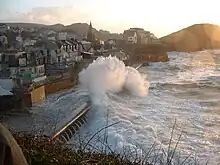Underwater construction
Underwater construction is industrial construction in an underwater environment. There is often, but not necessarily, a significant component of commercial diving involved.[1][2] It is a part of the marine construction industry.[3]
Scope and applications
Underwater construction is common in the civil engineering, coastal engineering, energy, and petroleum extraction industries.
Civil engineering
- Construction below the water table is mostly managed by using cofferdams or pressurised caissons to exclude water sufficiently to work above the local water level within the enclosure, though it may also be possible to keep the water level down by pumping it out as fast as it seeps in, thereby artificially lowering the water table at the worksite.
- Dams, reservoirs, canals, locks
- Bridges and causeways over bodies of water often require foundation structure below water level. Usually this is done using coffer dams and caissons, which themselves may involve underwater work.
Coastal engineering

Coastal engineering is a branch of civil engineering concerned with the specific demands posed by constructing at or near the coast, as well as the development of the coast itself.
Harbours, docks, breakwaters, jetties, piers, wharfs and similar structures are all immediately adjacent to, or project into coastal waters, and are supported in part by seabed.
Stormwater and sewer outfalls require pipelines to be laid underwater.
Energy infrasructure
- Inshore and offshore wind farms
- Tidal power and wave power generation
- Hydroelectric plant
- Power station cooling system intakes and outfalls
Offshore petroleum extraction
- Marine wellhead completions
- Offshore moorings
- Subsea pipelines
Relevant technology
- Civil engineering
- Coastal engineering
- Structural engineering
- Underwater concrete placement – Tremie, skip, pumping, toggle bags, bagwork.[4] Grouted aggregate.[4]
- Underwater rock blasting
- Dredging
- Piledriving
- Caissons and cofferdams
- Underwater surveying: site surveys and geological surveys
- Underwater inspection
- Underwater welding
- Commercial diving
- Hyperbaric work
- Corrosion protection
Occupational safety and health issues
Underwater work by divers on construction sites is generally within the scope of Diving regulations.[5][6] The work may also come within the scope of other occupational heath and safety related regulations.
Organisations
Military
- US Navy Underwater Construction Teams
See also
- Underground construction – Field of engineering for the design and construction of structures below the ground
- Offshore construction – Installation of structures and facilities in a marine environment
- Planetary surface construction – Construction of structures on planetary surface
- Space architecture – Architecture of off-planet habitable structures
- Underwater habitat – Human habitable underwater enclosure filled with breathable gas
References
- Brown, J. Mariah (27 January 2011). "Underwater Construction". buildipedia.com. Retrieved 1 August 2020.
- "Civil underwater construction". www.ducmarinegroup.com. Retrieved 1 August 2020.
- "Our industry". imca-int.com. International Marine Contractors Association. Retrieved 15 September 2020.
- Larn, Richard; Whistler, Rex (1993). "17 - Underwater concreting". Commercial Diving Manual (3rd ed.). Newton Abbott, UK: David and Charles. pp. 297–308. ISBN 0-7153-0100-4.
- "Diving Regulations 2009". Occupational Health and Safety Act 85 of 1993 – Regulations and Notices – Government Notice R41. Pretoria: Government Printer. Archived from the original on 2016-11-04. Retrieved 3 November 2016 – via Southern African Legal Information Institute.
- Staff (1977). "The Diving at Work Regulations 1997". Statutory Instruments 1997 No. 2776 Health and Safety. Kew, Richmond, Surrey: Her Majesty's Stationery Office (HMSO). Retrieved 6 November 2016.
| Occupational diseases and injuries |
|
|---|---|
| Occupational hygiene | |
| Professions | |
| Agencies and organizations |
|
| Standards | |
| Safety | |
| Legislation | |
| See also | |